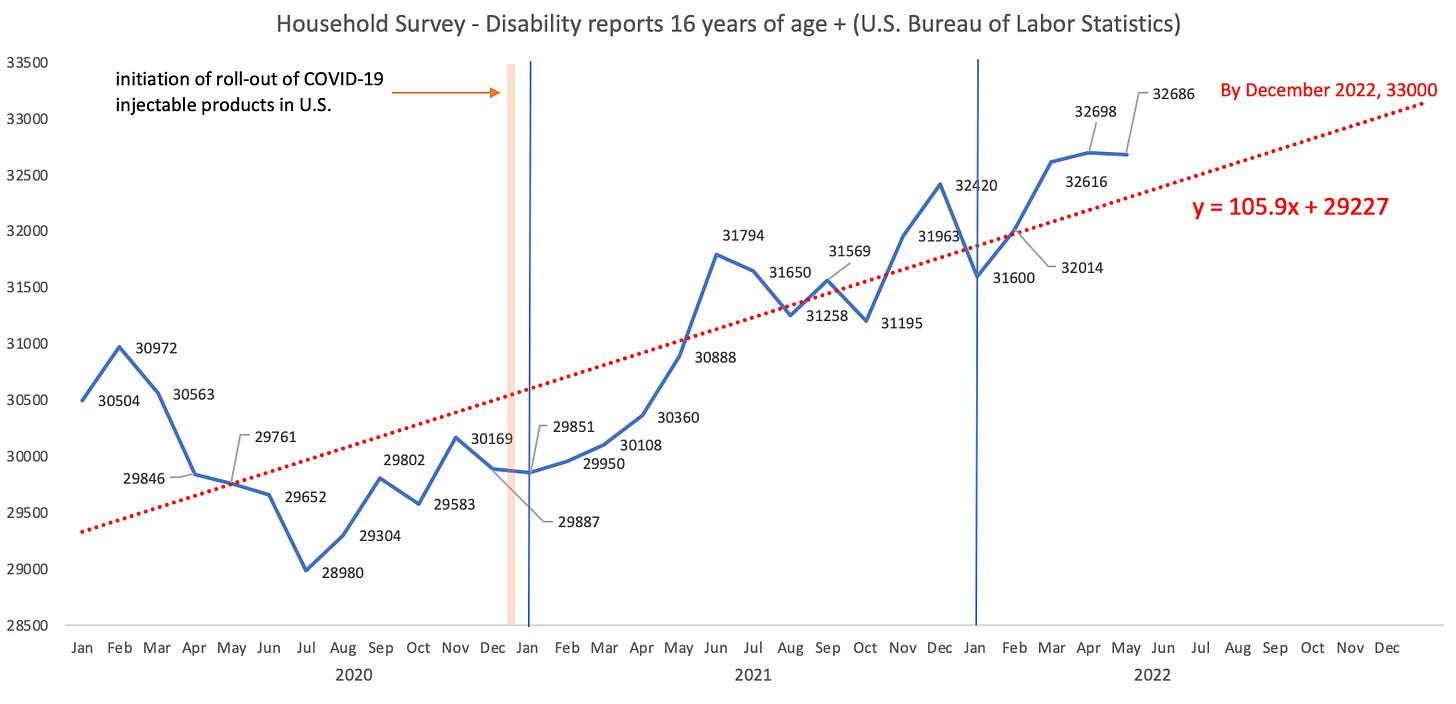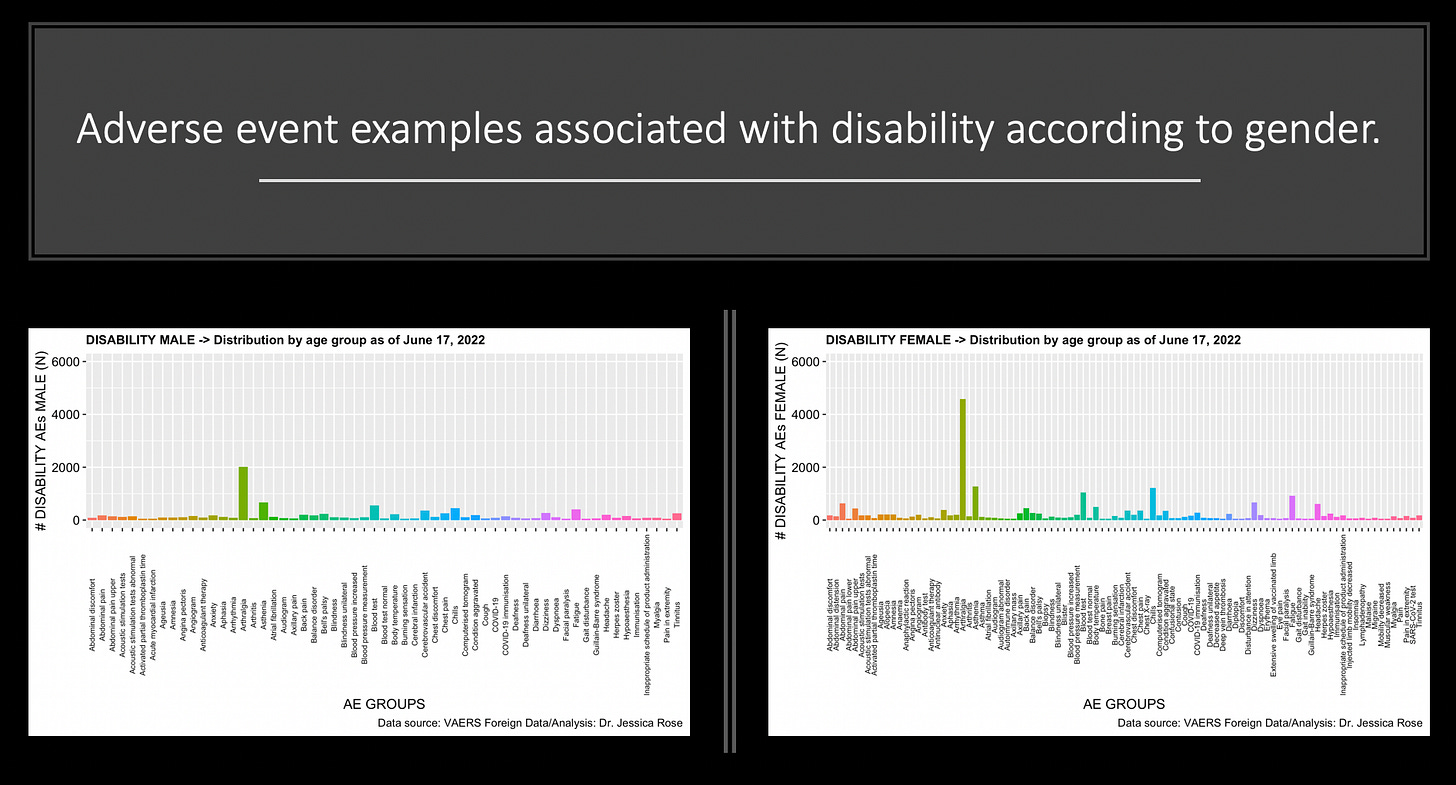Note: I started this the other day but got distracted.
I was on a call the other night with PANDA and Edward Dowd spoke. He spoke on new data concerning disability claims. This is a category in VAERS that I have been tracking for a long time now. According to sources, 2.9 million additional disability reports that came from household survey data have been reported since the injection roll-out. El Gato Malo wrote a great piece on this that you can read here.
There’s a graph that I can share from that post for U.S. citizens 16 years and older that will make it easy to see that there’s something ‘different’ about 2021 with regard to disability claims.
The data comes from the U.S. Bureau of Labor Statistics and collected using household surveys.
Household surveys are questionnaires that are given to a sample of households in a population. Their primary advantage is to provide considerable discretion to the interviewer about the information requested of respondents. Their major drawbacks are that information provided by the respondent is often inaccurate (response error), and, in many cases, the information requested is not provided at all (nonresponse problems).1
I always like to reproduce charts and results from original data sources so I did and I added a linear trend line. It’s really just a linear model that allows one to ‘forecast forward’ to guess what the future might bring if the trend continues. The slope is very positive and if the trend does continue, there is an anticipated 10.5% increase in disability claims (since the injection roll-out) and 10.3% above the average for 2020. There’s no way to know for sure if this trend will continue, however, but I would bet that the slope of this line might even increase.

So it seems from this reliable data set that there is an unexplained rise in disability claims in 2021 that continues into 2022. The means for 2020, 2021 and 2022 up until May are 29,918,583, 31,083,833 and 32,322,800. This ‘means’ (hardy har) that we are 3.9% and 8% above the average for 2020 in 2021 and 2022. Why?
In the meeting, there was mention of a skewed distribution of disability data when stratifying by gender. Apparently, more reports from females with disabilities were being filed. I imagine since this is household survey data that this means that more females are actually suffering rather than just simply filing disability claims. This is likely due to longer lifespan and degeneration of ability with age.
So I checked VAERS as a means to confirm this mention. Sure enough, there were almost twice the number of disability reports from females. The average age of the females reporting is 48 and for males, 52. The rate of reporting of adverse events to VAERS is higher for females (65.4% (F); 32.1% (M); 2.5% (U)), so this likely why we see more disability reports in VAERS from females. There are 793,195 reports in VAERS made by females and 389,082 made by males so the ratio is 2:1 which is comparable to the ratio of disability reports 32,693 (F) and 17,034 (M) at 1.9:1 so all I can really say about disability reports and gender skewing is that there are twice as many REPORTS made by females. I can’t really say anything about whether or not there are more incidents.
I also plotted the data in a single bar plot so everyone could visualize this way if that’s better. Notice that we lose ~20,000 data points from missing field entries in the age and gender variables.

This made me wonder if there was a way I could find out using VAERS data if any disabilities were being specifically reported to VAERS by females and not males. I mean, besides bleeding/menstrual disorders. I realize that there’s no real way to ascertain this definitively without background rates, but it might provide insight.

So there’s not much to say here on the subject of determining whether or not females are suffering more disability. These 13 stand-alone adverse events were selected randomly and only a couple (Bell’s palsy, Cardiovascular accident and Unilateral blindness) indicate that the men might be suffering more than women from these conditions. But, there’s no real way to know from this data. Females reported 1933 different types of adverse events while males reported 1,576 in the context of disability reports in VAERS. Many were menstrual disorders. Of the total types, 508 were reported for males that were not reported by females, and 865 were reported by females and not males. Below is a table showing the top 10 adverse event types reported for males (left) and females (right). Note the discrepancies in the absolute counts.

Just in case you’re wondering what kinds of adverse events are associated with disability as per gender, I made the following plots. Sorry for the small font.

Demographic characteristics In 2021, persons with a disability accounted for 11.9 percent of the civilian non-institutional population. Persons with a disability tend to be older than persons with no disability, reflecting the increased incidence of disability with age. In 2021, half of persons with a disability were age 65 and over, compared with 18 percent of those with no disability. Overall, women were somewhat more likely to have a disability than men, partly reflecting the greater life expectancy of women.
I’m going to post this article and come back to it. :) Hopefully. I am far too into the amyloidogenicity potential of spike peptides now to focus properly on anything else.
https://www.sciencedirect.com/topics/social-sciences/household-survey







I just came up with this on my 5 mile walk in the park:
The Jab Song
It was an itsy-bitsy teenie-weenie self-assembling nano-meanie
That they jabbed in her shoulder today.
An itsy-bitsy teenie-weenie terribly toxic nano-meanie,
And in her liver it wanted to play.
I'm cross posting this hoping three Substack Authors can work together on disability potentially caused by Covid-19 shots:
Jessica Rose: https://jessicar.substack.com/p/disability-claims-us-bureau-of-labor
Steve Kirsch:
https://stevekirsch.substack.com/p/a-cool-new-way-to-get-an-estimate
A Midwestern Doctor:
https://amidwesterndoctor.substack.com/p/a-massive-spike-in-disability-is
https://amidwesterndoctor.substack.com/p/all-evidence-suggests-the-covid-vaccines